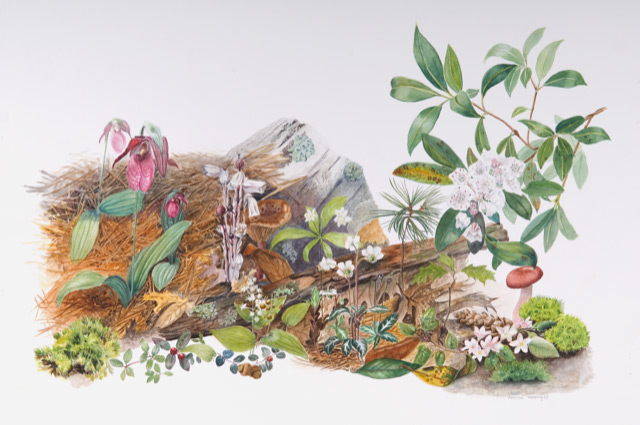- Apply
- Visit
- Request Info
- Give
Published on March 22, 2021
Frances Topping
Illustrative techniques
Illustrative techniques can be so varied depending on one’s skills and the project at hand. I prefer water color which can be very details or loose. A detailed object might have a loose background. Pen and ink are preferred for botanical species plates, graphite is often a starting place to formulate ideas, sketch to understand and sometimes a finished piece. Colored pencil is often used for fine detail, sometimes on plastic film for a glowing feel and a subtle background. Acrylics and oils have their aficionados too with some stunning images and are often used for larger displays or murals. Each technique has its place in the toolkit.
Precision
Precision in my work varies according to need. Being accurate, observing details, knowing what is essential are all aspects of precision. My work tends to be more interpretive than for documentation. For a scientific work it would be attention to every last detail since an error can make it a different species and expert scientific collaboration is needed as well as specimens to understand the morphology. Googling images can lead one astray and common names can be attributed to many different species! For an informational kiosk it might not need every last hair but needs to be the correct species and accurately drawn in correct habitat so that it is identifiable as in the Oak Pine Forest Flora. All of these species may not be seen so close together but all are in this habitat. An illustration can select details, expand them, combine them, show more than a photo where often shadows obscure detail. Precision depends on the goal and degree varies by project. Art and Science are intertwined, one helping the other.
Love
A love of nature and art began young growing up in England. I love to share that knowledge through teaching and leading interpretive walks or through interpretive illustration. I have painted large murals of a rainforest and of dinosaurs, created brochures and interpretive panels. Initially I studied geography earning a BS. It combines so many aspects of life from physical forms, economic geography, social aspects which helps with ecology and a knowledge of habitat. I also studied some botany and have taken natural history courses. All of which have helped in my art work. Later I took a BFA in Graphic Design with photography and illustration; later still a certificate in Natural Science Illustration at the Rhode Island School of Design. Much of my skill has been acquired through workshops, technique courses at conferences with the Guild of Natural Science Illustrators or with the New England Society of Botanical Artists, fine art workshops etc. and of course the continuing practice and patience the art requires. Patience, practice and persistence are key to learning how to accurately and aesthetically portray nature. Frances Topping, 2021.


